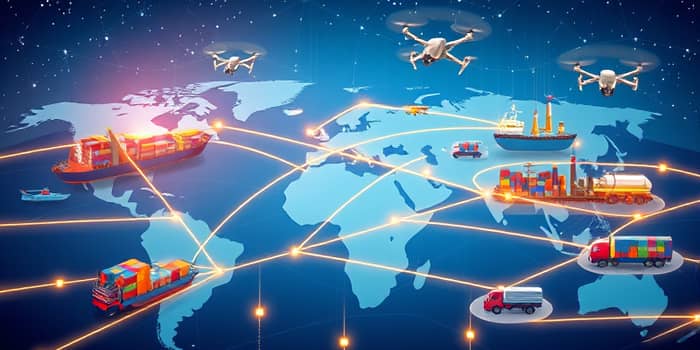
Since the global upheaval triggered by the COVID-19 pandemic and compounded by geopolitical tensions, supply chains have faced unprecedented challenges and opportunities. In 2025, organizations navigate a landscape defined by persistent volatility, inflationary pressures, and climate-related disruptions that continually test established models and strategies.
This article delves into the multifaceted drivers shaping supply chain performance, examines the rapid technological transformations underway, and offers practical guidance on resilience strategies—from multi-shoring and strategic inventory holding to advanced digitalization and sustainable practices. By exploring real-world statistics and emerging best practices, we aim to equip leaders with actionable insights to strengthen their networks and maintain competitive advantage in an uncertain global marketplace.
Macroeconomic instability and market turbulence exert a profound influence on global supply networks. According to the World Economic Forum, 56% of chief economists anticipate weaker economic conditions in 2025, while only 17% expect improvement. Inflationary trends and fluctuating demand patterns create a feedback loop, driving procurement costs higher and compressing margins. Concurrently, regional conflicts and evolving trade policies amplify uncertainty, forcing companies to navigate a labyrinth of tariffs, sanctions, and regulatory shifts.
Key risk factors include:
With 94% of firms reporting negative revenue impacts from disruptions, organizations must scrutinize each node within their supply network to anticipate and mitigate emerging threats. Strategic alignment with economic forecasts and scenario planning can enable more resilient decision-making.
Rapid advances in AI, automation, and IoT are revolutionizing how supply chains operate. In 2025, 82% of organizations increased IT spending, prioritizing digital platforms that deliver actionable insights. Adoption of cutting-edge predictive analytics enables real-time demand forecasting, reducing safety stock requirements and enhancing service levels. Robotics deployments, growing at 14% annually, now power over 4 million warehouse units, streamlining repetitive tasks and mitigating labor shortages.
Early AI adopters report logistics costs down by 15%, inventory levels falling by 35%, and service efficiency climbing 65%. To illustrate these impacts, the following table compares key performance metrics before and after AI integration:
Moreover, real-time visibility tools and digital twins empower stakeholders with end-to-end transparency, enabling faster response to disruptions and dynamic rerouting of shipments.
To withstand growing uncertainties, companies are reconfiguring their networks through balanced sourcing and enhanced contingency planning. Multi-shoring and supplier diversification now feature in half of all procurement strategies, driving a measured increase in reliability by approximately 10 percentage points. While such approaches can introduce complexity, they effectively reduce single-point failures and buffer against region-specific risks.
Inventory philosophies have also shifted away from lean just-in-time frameworks toward hybrid models that incorporate strategic buffers. Approximately 78% of firms leverage multi-shoring sourcing strategies alongside maintained safety stocks to manage supply continuity. This dual approach balances cost with operational security.
Investments in agile production planning and collaborative platforms further strengthen resilience. By integrating supplier portals and automated alert systems, organizations accelerate decision cycles and minimize lead times during disruptions. These practices exemplify a shift toward proactive supply network management that anticipates challenges rather than merely reacting to them.
Sustainability requirements are intensifying as stakeholders demand transparent, responsible supply chains that minimize environmental footprints. However, enforcement of ESG mandates varies significantly across regions, creating a patchwork of compliance challenges. In 2025, many organizations struggle to balance cost pressures with investments in green technologies and cleaner energy sources.
Leading firms are adopting circular economy principles, recycling materials, and partnering with suppliers who adhere to rigorous environmental standards. Emission reduction targets and social governance metrics increasingly factor into contract decisions, reflecting heightened expectations from investors and consumers alike. Despite uneven progress globally, embedding sustainability into core operations is transitioning from a competitive advantage to a baseline requirement, ensuring long-term viability amid regulatory evolutions.
Labor availability continues to be a pivotal constraint, with 62% of companies citing workforce shortages as a major operational challenge. The rapid pace of technological adoption intensifies the need for specialized skills in data analytics, robotics maintenance, and supply chain management. Yet, training programs lag behind, creating a talent gap that threatens to undermine full digital transformation potential.
In response, 53% of firms are ramping up recruitment efforts and investing in comprehensive upskilling initiatives. Partnerships with academic institutions and vocational training centers aim to cultivate a pipeline of qualified professionals. Additionally, flexible work arrangements and cross-functional rotational programs increase retention by providing diverse career pathways and fostering a culture of continuous learning.
Looking ahead, supply chain leadership will hinge on the ability to blend agility with strategic foresight. The concept that “the real competition is between supply chains, not companies” underscores the importance of inter-organizational collaboration and shared intelligence. Real-time data exchanges, joint scenario modeling, and collaborative risk assessments will differentiate industry frontrunners.
Resilience investments, while elevating short-term costs, yield durable benefits in risk mitigation and market responsiveness. Firms that embed AI-driven decision engines alongside adaptive supply chain architectures can swiftly reroute flows, maintain service continuity, and capitalize on emerging opportunities. As macroeconomic headwinds persist, the strategic interplay of technology, talent, and sustainability will shape the competitive terrain for years to come.
The next frontier involves leveraging AI-driven decision engines, decentralized ledger technologies for transparent provenance, and advanced robotics to redefine fulfillment paradigms. Ultimately, organizations that embrace holistic resilience strategies will secure a sustainable advantage in a volatile global marketplace.
References





